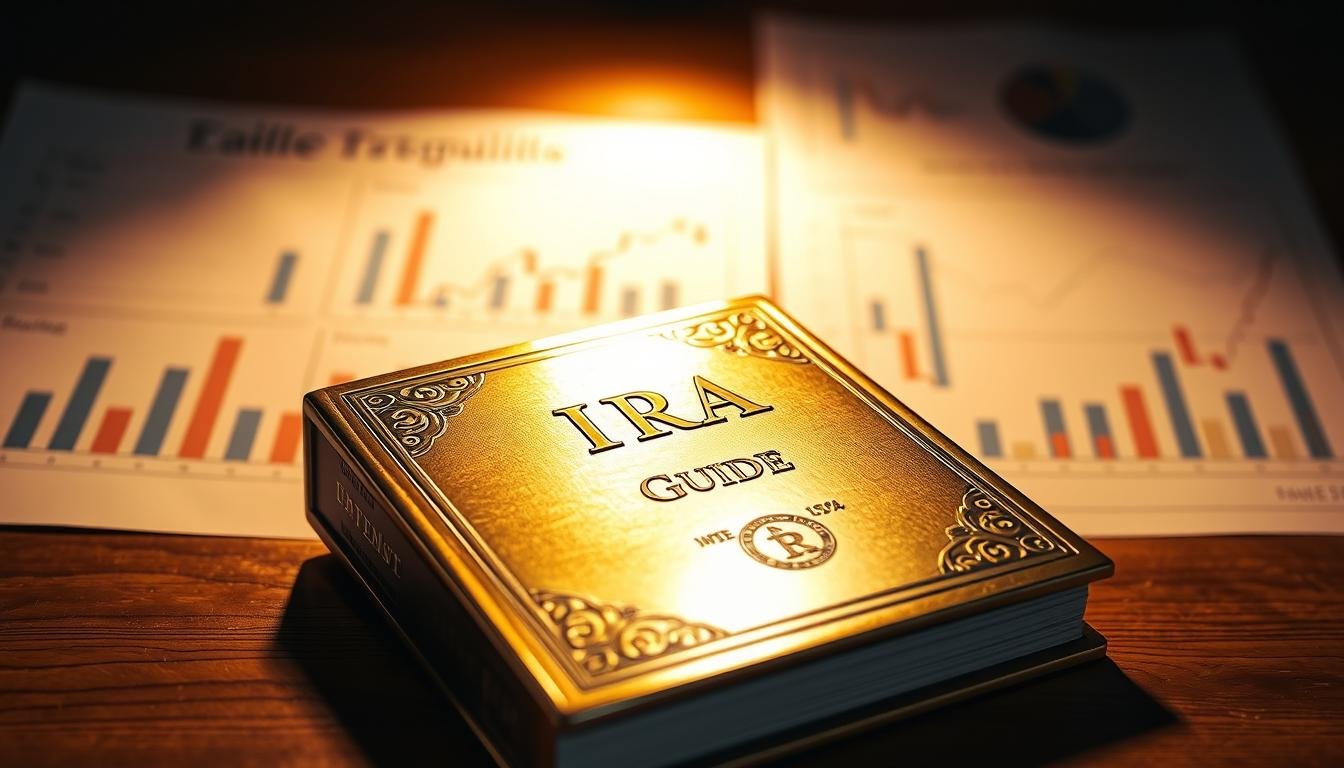I remember the night I first worried about the future of my savings. Markets were noisy, headlines shouted about slow growth and rising prices, and I felt the urge to act rather than freeze.
So I started looking into a gold IRA as a practical way to protect my plan during uncertain time. I wanted something that complements my portfolio, not replaces it, and that keeps my money working under tax-advantaged rules.
I like that a Gold IRA holds physical metals in an IRS-approved depository—no home storage—and offers a tangible buffer when stagflation pressures push inflation higher. I also know there are real trade-offs: setup, custodian, storage, and insurance fees, and no dividends.
My approach is modest: a small allocation, common guidance suggests 5–10%, to balance growth and safety. This piece is my buyer’s guide to learn how a Gold IRA works, where it fits, and how to open and maintain one without hype.
Key Takeaways
- Understand how a Gold IRA stores metals in IRS-approved depositories.
- Consider a modest allocation (5–10%) to balance growth and protection.
- Expect ongoing fees for setup, custody, storage, and insurance.
- Gold can act as a safe-haven during stagflation and low real rates.
- Use this guide to learn steps to open, fund, and maintain an account.
Why I’m Considering Gold Right Now: Stagflation Risks to My Retirement Income
I wake up some mornings worried that slow growth and steady price gains will shrink what my savings can buy. That worry is the reason I began mapping how persistent inflation plus weak growth hits my plan.
How stagflation erodes purchasing power and cash flow
Stagflation pairs higher consumer prices, a slowing economy, and rising unemployment. For people living on fixed or semi-fixed payouts, that trifecta reduces my purchasing power and forces larger withdrawals just to keep the same lifestyle.
The present landscape in the U.S.
Today I see sticky inflation, uneven growth signals, and market uncertainty that can whipsaw valuations. Tariffs and geopolitical tensions can push costs higher and strain supply chains, making everyday prices—at the pump and grocery—feel heavier on my budget.
When safe-haven demand tends to rise
Historically, demand for gold climbs when confidence fades and real rates fall. Central banks buying bullion and low or negative real yields lower the opportunity cost of holding non-yielding assets, so gold often looks more attractive in these times.
Gold IRA Basics: How a Self-Directed IRA Lets Me Own a Tangible Asset
I learned that a self-directed IRA lets me swap paper holdings for a tangible asset stored by professionals. A gold ira is a type of self-directed account that lets me hold physical bullion and other approved metals instead of stocks or mutual funds.
How it differs from a standard IRA
Unlike traditional brokerage IRAs, this account allows direct ownership of physical metals. My purchases, fees, and sales must flow through the ira so the tax status stays intact.
Tax treatment: Traditional vs. Roth
Traditional SDIRA gold holdings are tax-deferred; withdrawals are taxed as ordinary income and face a 10% penalty if taken before age 59½. Roth SDIRA qualified distributions are tax-free, which changes how I plan my withdrawals and long-term tax math. RMDs apply to Traditional accounts starting at age 73.
Storage and eligible bullion
The IRS requires storage in an approved depository—no home safes or bank boxes. Eligible gold must meet a 99.5% fineness standard; common choices include the Canadian Maple Leaf and the American Buffalo. Typical costs I budget for are setup ($50–$150), custodian fees ($100–$300/yr), and storage/insurance ($100–$150/yr).
- Keep all money inside the SDIRA to avoid prohibited transactions.
- Remember gold and similar assets don’t pay dividends; returns rely on price changes and diversification benefits.
hedging retirement income against stagflation with gold ira
I look for assets that behave differently from stocks so my plan doesn’t fall apart when markets turn. Adding a low-correlation holding can reduce the chance that everything falls together during a shock.
Why low correlation matters
When equities slide, a differently behaving asset can smooth my portfolio swings. Historical data shows this asset class often moves independently of stocks and bonds. That independence helps keep my balances steadier in turbulent times.
Preserving value as rates and the dollar shift
During periods of rising prices and weak growth, safe-haven demand can lift prices—especially when real rates are low. A softer dollar and central-bank buying can add to that support. I view this as a way to preserve value, not chase quick gains.
- I aim for resilience, not perfect timing.
- A compliant account provides physical exposure while custodians handle storage and insurance.
- This complements my core holdings rather than replaces them.
Who a Gold IRA Fits (And Who It Doesn’t) for Long-Term Wealth Preservation
I ask whether stability or maximum growth matters more before I change my portfolio. A Gold IRA tends to suit investors who prioritize preservation and diversification over aggressive gains. It acts as a balancing asset that can hold value during market shocks.
If I prioritize stability over aggressive growth
Why it fits: I value stability and long-term wealth preservation. For investors seeking lower correlation to stocks, this option can reduce portfolio swings during crises.
Liquidity needs, income goals, and risk tolerance checks
Physical transactions take time and fees are higher than standard brokerage accounts. If I need quick cash or steady income, this choice may not suit my near-term goals.
- I accept that stocks often outpace gold over long horizons, so I use this as a complement, not a replacement.
- I test my risk tolerance: if a small allocation helps me sleep better during downturns, it can be worth the trade-off.
- My checklist before I proceed: a cash reserve, clear income needs, allocation limits, and comfort with ongoing storage fees.
The Balanced View: Advantages and Trade-Offs I Need to Weigh
I want a clear-eyed view: what helps my plan in bad times and what could hold it back in good ones?
Advantages I Count On
Diversification matters. Adding an asset that behaves differently from my stocks and bonds can smooth swings when markets get choppy.
Value and tangible ownership give me comfort — a physical holding can act as a hedge during high inflation or stagflation. That characteristic often shines in crisis times.
Trade-offs and Ongoing Costs
I balance those benefits against clear trade-offs. There are setup, custodian, storage, and insurance costs. There are no dividends, and over the long run stocks often deliver stronger growth.
“I treat this as insurance for value, not a shortcut to beat equity returns.”
Rules That Affect My Plan
I also factor in early withdrawal penalties and required minimum distributions. Taking money before 59½ can trigger a 10% penalty plus taxes, and RMDs at age 73 can affect my liquidation timing.
- I place this holding inside a wider mix of investments so I don’t crowd out productive growth.
- I monitor real rates and price action, since those move the opportunity cost of holding non-yielding assets.
- For deeper detail on fee planning, I review understanding the costs.
Step-by-Step: How I Open, Fund, and Buy IRS-Approved Gold in My SDIRA

The practical steps—custodian, funding, purchase, and storage—kept my plan focused and compliant.
I begin by shortlisting custodians that support precious-metal self-directed accounts and publish clear fee schedules. I look for transparent setup and annual custodian charges so I can compare total costs.
Then I open the ira account and fund it via a direct transfer, rollover, or new contribution. I insist on trustee-to-trustee moves to avoid triggering taxes or holding personal cash in the account.
I choose IRS-eligible gold that meets the 99.5% fineness rule, such as the Canadian Maple Leaf or American Buffalo. I weigh coins versus bars on premiums, liquidity, and storage fees.
- I direct the custodian to execute the purchase so title and depository records list the account, not me.
- I confirm storage at an IRS-approved depository and verify insurance and reporting.
- I pay setup ($50–$150), custodian ($100–$300/yr), and storage/insurance ($100–$150/yr) from the IRA funds.
- I keep proceeds and expenses inside the account, never mixing personal cash, and retain all confirmations for tax records.
- I monitor prices, premiums, and allocation weight and plan liquidity for fees or future RMDs.
“I treat each transaction as an investment instruction documented and retained for compliance.”
Choosing a Gold IRA Company: My Due Diligence Checklist
I start by treating the selection process like due diligence on any serious investment partner. I want clear answers before I let anyone touch my money or move metals into an account.
Reputation signals
I scan BBB and Trustpilot reviews to see how companies handle complaints and claims. I read recent customer feedback to judge responsiveness and real problem solving.
Coordination and buyback clarity
I confirm the dealer works smoothly with my chosen custodian and an IRS-approved depository. I read buyback policies closely to understand price methodology, timelines, and any fees when I sell or meet RMDs.
Transparent fees and fair service
I insist on a written fee schedule so I can compare total costs. I favor teams that educate and offer no-pressure guidance on strategies and allocation.
Operational controls and support
I check segregation of duties, online reporting, and how easy the portal is to use. I test customer service with specific questions to see how they perform under uncertainty.
- I shortlist contenders that balance low fees, strong service, and tight operational controls.
- I pick the firm that gives clear answers, fair prices, and a documented path for account setup and future sales.
Costs, Risks, and What They Mean for My Net Returns

I count every annual fee because small expenses chip away at my net return over time.
Setup, custodian, storage, and insurance fees to budget for
I line-item typical expenses so I know the drag on returns. Setup often runs $50–$150, a custodian usually charges $100–$300 per year, and storage plus insurance can add $100–$150 annually.
I keep spare funds inside the account for those recurring charges so I don’t sell at a bad price or disrupt my plan.
Market risk, price volatility, and opportunity cost vs. stocks and bonds
Gold can swing widely; I set expectations for volatility and treat this holding as ballast, not a guaranteed gainer.
Because metals do not pay dividends, choosing them over dividend-paying stocks or interest-bearing bonds carries an opportunity cost in my income and total-return mix.
How rates, the dollar, and geopolitical tensions can move gold prices
Macro levers matter: falling real rates or central-bank purchases tend to lift prices, while a stronger dollar can pressure them.
Geopolitical shocks often spark safe-haven demand quickly, and stagflation or rising inflation can change correlations between asset classes.
- I compare net performance to a blended benchmark of my stock and bond mix, not to metals alone.
- I document an investment thesis and clear risk limits so I can act calmly when the market gets noisy.
- I revisit costs each year and negotiate or switch providers if service or pricing worsens.
“Small annual fees compound; controlling them helps protect long-term net returns.”
Smart Allocation Strategies: Blending Gold with Stocks and Bonds in My Retirement Portfolio
A simple rule helps me decide how much of my nest egg sits outside stocks. I use a modest target range so diversification enhances resilience without sacrificing long-term growth.
Position sizing ideas
I usually size this exposure at about 5–10% of the total portfolio. That range aims to boost diversification while letting stocks drive growth over long periods.
When to rebalance
I set clear triggers: either annual reviews or percent bands (for example, ±2–3% from target). Rebalancing trims winners and tops up laggards, keeping my risk profile steady across different market periods.
- I design a glidepath that leans into stocks early for growth and shifts slowly toward defense as time to drawdown shortens.
- I blend bonds of varying durations alongside this allocation because changing rates and inflation can favor short or long bonds at different times.
- I add investing gold exposure gradually to avoid timing risk and to match my comfort and market conditions.
“I focus on total-portfolio value preservation, not the standalone performance of any single holding.”
Staying Compliant: IRS Rules, Prohibited Transactions, and RMD Considerations
I keep compliance at the top of my checklist so tax rules don’t undo a good plan.
IRS rules ban self-dealing and personal use. Every purchase, fee, and sale must go through my account so personal cash never touches IRA funds.
Prohibited counterparties and assets to avoid
Avoid family members, personal companies, and any dealer that would route payment outside the account. Collectibles are disallowed unless bullion meets IRS fineness standards.
I confirm eligible coins meet the required purity and reject items that could be classified as collectibles.
Roth vs. Traditional rules, UBIT, and documentation
Traditional accounts face RMDs starting at age 73; Roth accounts follow different distribution rules that usually avoid RMDs during my lifetime.
If an investment uses debt or runs an active business, UBIT can apply. I check structure before I buy to prevent surprise taxes.
| Compliance Area | What I Do | Why It Matters |
|---|---|---|
| Counterparties | Use only approved dealers and custodians | Prevents prohibited transactions |
| Storage | IRS-approved depository only | Maintains tax-advantaged status |
| Documentation | Keep trade confirmations and invoices | Proof if audited |
| Tax Triggers | Monitor UBIT and RMD dates | Avoid unexpected tax bills |
My checklist is simple: route every instruction through the custodian, store all records, plan RMD liquidity for Traditional accounts at age 73, and review custodian policies and IRS updates periodically.
“I centralize trade confirmations, statements, and depository records so I can prove compliance quickly.”
Conclusion
I choose a measured path that blends protection and growth over many market cycles. I consider a gold ira to defend my purchasing power and to help shield my retirement from stagflation pressures.
Success comes from discipline, not timing. I focus on simple strategies over time, keep fees visible, and accept trade-offs like lower liquidity and no dividends.
I emphasize compliance: IRS-approved depository storage, eligible bullion, and clean documentation keep tax benefits intact. That discipline preserves long-term wealth and value.
I size exposure in the single digits so my portfolio keeps growth engines working. Other investors may choose different mixes based on liquidity needs, risk, and value goals.
Action list: shortlist providers, compare fees and money flows, confirm storage, and set a rebalancing timetable I will follow as the economy evolves.
FAQ
What exactly is a Gold IRA and how does it differ from my current IRA?
A Gold IRA is a self-directed retirement account that holds physical precious metals that meet IRS standards, rather than stocks, bonds, or mutual funds. I still get the same tax-deferred or tax-free benefits depending on whether I use a Traditional or Roth SDIRA, but custody, storage, and the asset types are different. Unlike a regular brokerage IRA, I cannot hold the metal at home and must use an IRS-approved depository. The account structure lets me add tangible assets to diversify my portfolio and help protect purchasing power during periods of inflation or market stress.
How does stagflation reduce my purchasing power and cash flow?
Stagflation combines rising prices with slow economic growth and often weak job markets. That mix erodes what my saved dollars can buy, while investment returns from stocks and bonds can stall. If wages and portfolio growth don’t keep up with inflation, my retirement cash flow can shrink. That’s why I’m considering tangible assets that historically maintain value better when the dollar weakens.
Can adding physical metal to my IRA stabilize my portfolio during volatile markets?
Yes. Gold and similar metals often have a low or negative correlation with stocks and bonds, so they can reduce overall portfolio swings. I don’t expect them to outperform equities in long bull markets, but they can preserve value when markets fall or when inflation rises unexpectedly.
What tax implications should I consider between a Traditional and Roth SDIRA holding metal?
With a Traditional SDIRA, contributions may be tax-deductible and withdrawals are taxed as ordinary income in retirement. With a Roth SDIRA, I fund the account with after-tax dollars and qualified withdrawals are tax-free. The metal itself doesn’t change tax rules, but I must follow distribution rules, required minimum distributions (for Traditional IRAs), and be careful with prohibited transactions to avoid penalties.
Are there specific purity standards and types of gold I can buy in an SDIRA?
Yes. The IRS requires certain minimum fineness—typically 99.5% for gold bullion. Accepted forms include specific coins and bars from approved refiners. I usually compare coins versus bars for liquidity, premiums, and storage implications before directing a purchase.
Where must the metal be stored and who handles that?
I cannot store IRA metals at home. The IRS requires storage in an approved depository or vault. The custodian I select coordinates with an approved depository for secure storage, insurance, and recordkeeping. That coordination is part of the fees I should expect.
What fees should I budget for when using a self-directed IRA for precious metals?
Typical costs include account setup, annual custodian fees, storage and insurance fees charged by the depository, and dealer premiums on the metal purchase. I also account for potential sale spreads and shipping. These reduce net returns, so I weigh them against the diversification benefits.
How liquid is metal held inside an IRA compared with stocks or bonds?
Liquidity tends to be lower. Selling bullion can take longer and may involve dealer bid/ask spreads and shipping logistics. That’s why I think about my short-term cash needs and avoid over-allocating if I expect near-term withdrawals.
What are the main risks and trade-offs I should know before adding metal to my SDIRA?
The big trade-offs are fees, no interest or dividends, and potentially lower long-term growth compared with equities. Price volatility and market timing also matter. I balance these against inflation protection, reduced correlation, and the tangible nature of the asset when considering my allocation.
How much of my portfolio should I consider allocating to precious metals?
Many financial planners suggest a modest allocation—commonly 5–10%—to gain diversification without sacrificing growth potential. My exact percentage depends on my time horizon, risk tolerance, and income needs. I rebalance periodically to maintain my target exposure.
How do I choose a reputable custodian, dealer, and depository?
I vet companies by checking Better Business Bureau ratings, Trustpilot reviews, clear pricing, transparent buyback policies, and their track record with SDIRAs. I prefer firms that explain fees upfront, coordinate smoothly among custodian, dealer, and depository, and offer responsive, no-pressure customer service.
Can I roll over an existing 401(k) or IRA into a self-directed account to buy metal?
Yes. I can move funds via direct rollover or trustee-to-trustee transfer into a self-directed IRA that allows precious metals. I avoid indirect rollovers to prevent tax issues and talk with the receiving custodian to ensure the transfer complies with IRS rules and avoids penalties.
What prohibited transactions and IRS traps should I avoid?
I avoid buying metal for personal possession, engaging in transactions with disqualified persons (family members or certain service providers), and using IRA assets as collateral. Violating these rules can trigger disqualification of the IRA and immediate taxation plus penalties.
How do market forces like interest rates and dollar strength affect metal prices?
Metal prices often move inversely to the dollar and can rise when real interest rates fall. Geopolitical tensions, inflation expectations, and central bank actions also influence demand. I watch macro drivers because they affect timing and potential price swings.
Will holding metal inside my SDIRA trigger unrelated business income tax (UBIT)?
Generally, owning physical bullion inside an IRA does not create UBIT. However, if the IRA engages in certain leveraged transactions or uses business operations, UBIT can apply. I consult a tax advisor to confirm for my specific strategy.
How do I handle ongoing management, like paying fees and reporting gains?
Fees are typically deducted from the IRA, not from my personal account. When I sell metal inside the SDIRA, gains stay within the account until I take distributions, at which point tax rules for Traditional or Roth accounts apply. I keep accurate records and coordinate with my custodian for reporting.
Are buyback guarantees important when selecting a dealer?
Yes. A clear buyback policy gives me confidence I can liquidate metal at a published spread. I compare dealer offers, premiums, and historical buyback behavior to avoid surprise costs when I need to sell.




